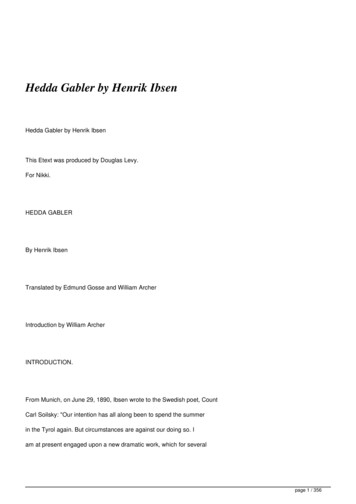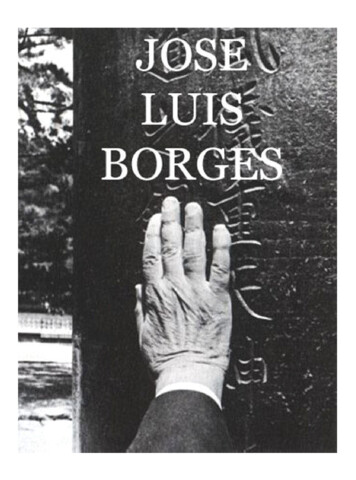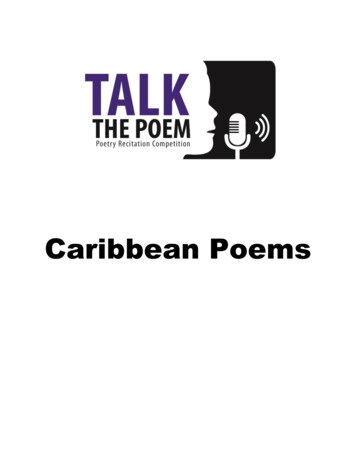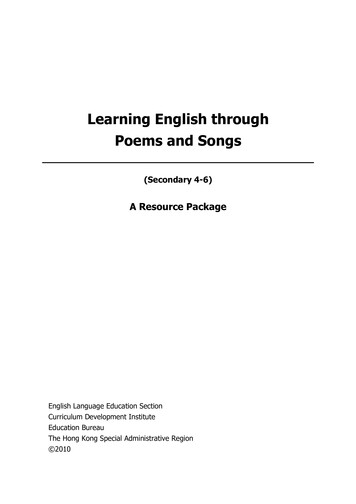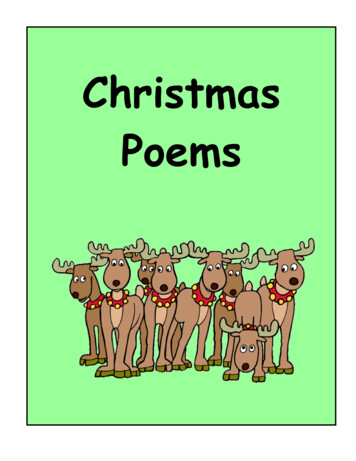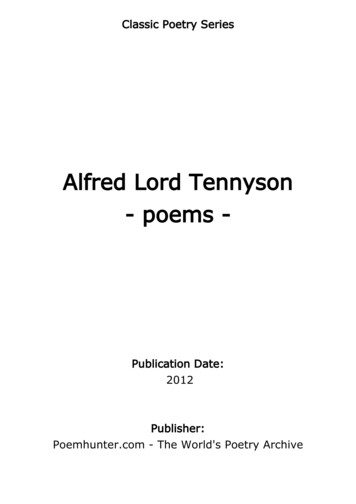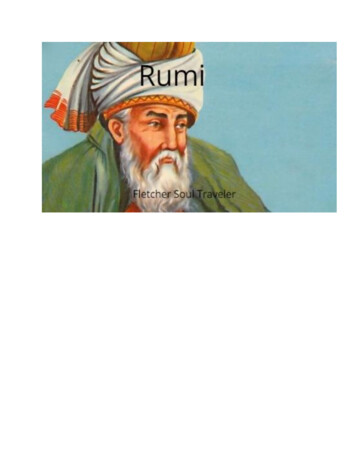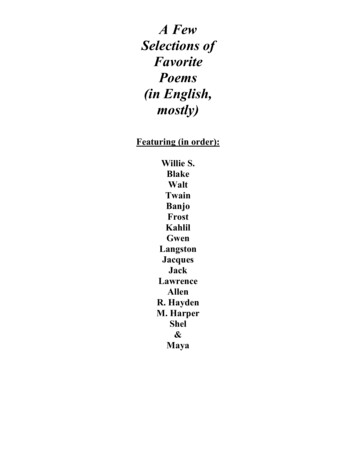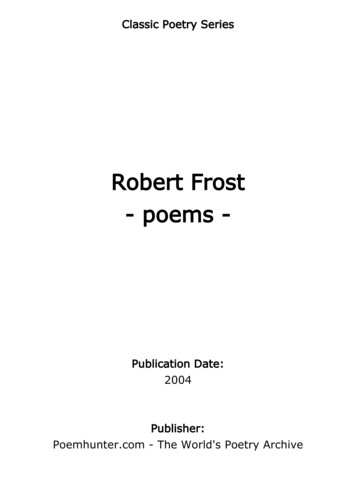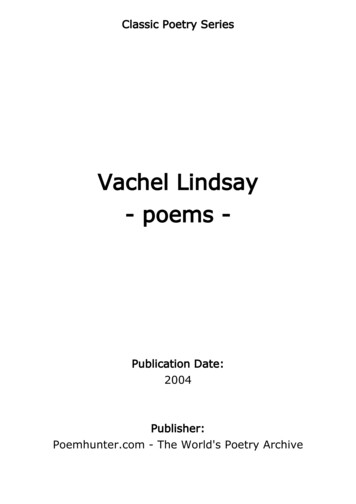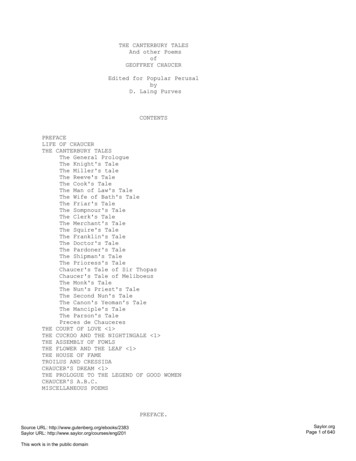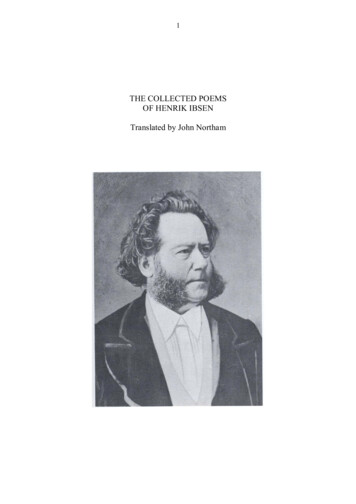
Transcription
1THE COLLECTED POEMSOF HENRIK IBSENTranslated by John Northam
2PREFACEWith the exception of a relatively small number of pieces, Ibsen’s copiousoutput as a poet has been little regarded, even in Norway. The English-reading publichas been denied access to the whole corpus. That is regrettable, because in it can betraced interesting developments, in style, material and ideas related to the later proseworks, and there are several poems, witty, moving, thought provoking, that areattractive in their own right.The earliest poems, written in Grimstad, where Ibsen worked as an assistant tothe local apothecary, are what one would expect of a novice. Resignation, Doubt andHope, Moonlight Voyage on the Sea are, as their titles suggest, exercises in theconventional, introverted melancholy of the unrecognised young poet. MoonlightMood, To the Star express a yearning for the typically ethereal, unattainable beloved.In The Giant Oak and To Hungary Ibsen exhorts Norway and Hungary to resist theactual and immediate threat of Prussian aggression, but does so in the entirelyconventional imagery of the heroic Viking past.From early on, however, signs begin to appear of a more personal andimmediate engagement with real life. There is, for instance, a telling juxtaposition oftwo poems, each of them inspired by a female visitation. It is Over is undeviatinglyan exercise in romantic glamour: the poet, wandering by moonlight mid the ruins of agreat palace, is visited by the wraith of the noble lady once its occupant; whereuponthe ruins are restored to their old splendour. The next poem, Room to Let, draws, asits title implies, on a wholly different source of inspiration: Ibsen’s own desperateneed, as a sex-starved youngster, to persuade a girl, any girl, to move into his untidylodgings and help transform their squalor into a treasure house. Ibsen is beginning totackle real life.Another piece, Memories of a Ball, provides a more complex and explicitindication of Ibsen’s impulse to reject convention for realism. Part poem, part prose,the piece is a long one because Ibsen needs not merely to express a subjective moodbut to argue a case. It begins conventionally enough with a prologue, a tribute to theethereal beloved, Stella, whom Ibsen borrows, as it were, from the famous poetWergeland. But the poem quickly modulates, after a hint or two of parody, into arefutation of such posturing and a robust counter-assertion that the true facts of thesexual game are to be found closer to home, at a dance. “That may ring a little flat /and moreover unpoetic” Ibsen writes, but he proceeds to an amusing and acutelyobserved account of the goings-on at such an event. The prose ending, the last pageof a disappointed lover’s diary, may revert to the old-style suicidal gloom, but thegloom is so extreme and Ibsen’s use of emotive dashes so excessive as to inviteridicule for an outworn romantic attitudinising.Ibsen entered a new world when he moved to the capital, Christiania, as awould-be student in the Medical Faculty. The University, a recent foundation, was anexciting assertion of Norway’s cultural independence from Denmark. Although hefailed, in Greek, to gain admission, he was accorded the status of “student” and wasthus able to play some part in undergraduate life. The change is reflected in thegeneral tone of the poems written during this period. The frustrated gloom manifestsitself still in, for instance, The Miner and Bird and Bird-Catcher, but even there Ibsenbegins to draw inspiration from a real-life occupation and from his own boyhood
3recollections. In The Lad in the Bilberry Patch he punctures the facile sentimentalityof a city poet by revealing the real facts, of poverty and sickness, that motivate thelad’s industry; The Tear stems from vivid memories of his own boyhood grief whenhe could not join his toboganning friends because his boots had come apart. ASaturday Evening in Hardanger offers the routinely folk-loreish account of the sourceof poetic inspiration but the poet is the local travelling tailor and the setting anamusingly observed dance in a farmyard, with young couples slipping off into thewoods under the sardonic gaze of their elders.There are reversions to self-pity — in The Eider Duck for instance — and tothe old nostalgia for the heroic past in To Denmark; but On Ladergaardsøen ends onthe hopeful note of a spiritual regeneration as does the long Prologue written for thenew, specifically Norwegian Theatre that had been founded in Bergen. There is amajor reversion, also, to the stock heroic mode in Ibsen’s first attempt at epic form,Helge Hundingsbane. It is a well-told tale of derring-do, but it displays Ibsen’sunreflecting acceptance at this time of its essentially brutal values — Helge is a herobecause he slays many men including the father and brothers of his beloved, Sigrun.She, undaunted, remains true to him and joins him in death as his shield-maid inValhalla. Ibsen was to write other epics and quasi-epics but they were to defineheroism in a more adult and perceptive way. It is perhaps significant that the poemfollowing Helge Hundingsbane, the last written during this period, is A Leg-Pull, asatirical barb aimed at stock poetical sentimentality.Ibsen’s move to Bergen as resident dramatist at the Norwegian Theatre thereinvolved him in an exciting and challenging undertaking, but it threatened to imposenew restrictions on his budding freedom from conventions. Almost as soon as hearrived he was cast in the role of occasional poet — for weddings, club meetings,official visits and other celebrations. The occasions themselves demanded a certainappropriateness of tone and sentiment; Ibsen often played safe by choosing, andsometimes somewhat laboriously developing, an all-too-obvious imagery: a seacaptain’s married life will be a sea-voyage, a theatrical couple will play their parts inlife and the theatre until the final curtain. But more limiting were the constraintsimposed on meter and stanzaic form by the fact that such occasional poems weremeant to be sung to a well-known melody. Ibsen’s individuality as a poet is, inconsequence, largely obliterated.There are, however, other indications. The Prologue to a matinee performanceat the Norwegian Theatre is an engagingly direct assessment of its modestachievements to date and it convinces one of Ibsen’s sense of commitment to theenterprise. Occasional poems such as Greetings to the Viceroy and Song at theCelebration of our Forebear’s Memory may draw on traditional heroics but in themIbsen begins to translate heroism into terms of moral courage or largeness of vision inthe face of the actual dangers and perplexities of contemporary life. Even amongstthe seemingly routine love poems — To my Primrose, To R.H, With a Rose, — thereare others, To Susannah Thorensen, To the One and Only, Wild Flowers and PottedPlants, that convince one that Ibsen is writing not to an incorporeal idea but to a realgirl valued for her inner resources of character; and A Bird Song is a vivid,humorously unpompous record of an embarrassing moment in Ibsen’s real lifecourtship of Rikke Holst.
4One further development deserves attention.In the Picture Gallerydemonstrates Ibsen’s desire to engage seriously with the complexities of being a poetin real life, a desire that generates a need for an expansiveness in a form far removedfrom the jejune narrative of Helge Hundingsbane. The piece is not in epic form butof epic length — a sequence of thirty-three sonnets; it is both a lively account ofIbsen’s visit to one of Dresden’s galleries during his tour abroad and an extendedexploration into the painful frustrations of the creative artist.Most of the poems that Ibsen wrote after his return to Christiania to work inthe Norwegian Theatre there were occasional — but occasional with a difference. Inpiece after piece his purpose is no longer, as so often in his early poems, to urge aking or a nation to take up the sword against oppression. Instead he exhorts a nationto establish its independence through the integrity of its language and culture, not justof its frontiers. His new heroes are King Oskar, a patron of the arts and literature inNorway, Ole Vig, a leader of educational reform, Professor Schweigaard and J. L.Heiberg, prominent intellectuals of the day, and Chr. Jørgensen, a famous actor. It isthrough such men that nations can achieve their true and proper stature. The fullweight of Ibsen’s contempt for those that betray the obligations of such leadership canbe felt in the two lengthy, scathing letters to H. Ø. Blom.Two works of this period deserve particular attention. They are both verylong. One, On the Heights, is a kind of spiritual epic, tracing the dilemma of the poettorn between his longing for the normal satisfactions of life and the exigent demandsof art. The other, Terje Vigen, is a true epic, one that attains, more fully than any ofthe previous poems, the objectives towards which Ibsen has been working. Terjebegins as a humdrum figure out of real life, a fisherman, but Ibsen goes on to developa sense of his heroic stature; not merely in terms of the suffering he endures duringthe English blockade of Norway, but of the spiritual strength he manifests when hebrings himself to forgive the man responsible for the ruin of his life. The poempierces to the core of Terje’s integrity as a great human being; the condensed, allusiveimagery of the last few lines is perhaps the most poignant that Ibsen ever employed:the humble, neglected grave, the rough grass growing around it, and the wild flowersthat show through.There is no mistaking the liberating effects of Ibsen’s departure for foreignparts. In From my Home Life and The Gulley his concern is still, narrowly, his ownprivate problems as a poet, but he ranges more widely in subject-matter and forms.The targets for his contempt take on a cosmopolitan dimension. Abraham Lincoln’sMurder is a trenchant condemnation of the moral hypocrisy of Europe at large; To theRevolutionary Orator dismisses the ineffectual posturing of a purely theoreticalrevolutionary fervour. The perspectives are broader, though the forms are familiar.The Epic Brand suggests a new development. The setting appears to benarrowly Norwegian, yet in this very long fragment Ibsen is clearly trying topersonify the conflict that he has explored in more general terms, namely the conflictbetween integrity and a corrupt social environment. It was a theme dear to Ibsen’sheart, yet, after a year’s laborious effort and more than a hundred stanzas, he suddenlyabandoned the project.Several reasons have been adduced, but it seems likely that Ibsen had come tofeel constrained by his narrative form. The fragment is impressive, but most readers
5would testify to its slow space, to the retarding effect of the stanzaic structure.Characters, settings, actions — everything has to be described. Yet at the very endIbsen seems to hit upon a dramatic alternative. It presents itself in the scene showingan asinine bailiff distributing relief to the starving peasants. At last the Epic Brandshows that a slow-moving narrative might be turned into a lively dramatic encounter.For whatever reason, Ibsen abandoned the repetitive form for the flexible rhyming,the swift pace, the immediacy and variety of his great dramatic poem Brand whichcan be thought of as his first modern tragedy.It is indisputable that the finest of Ibsen’s later poems benefit both from theenlargement of his experiences abroad, and from a new flexibility of form, though thepreoccupations remain the same. Balloon Letter to a Swedish Lady, written in alively, ode-like form, is not only an amusing travelogue of Ibsen’s trip to Egypt but itconcludes with a damning comparison between the lifeless, sacerdotal culture of thatcountry and the deadening authoritarianism of contemporary Prussia. His aim is todefine the difference between a distorted and a genuine concept of national identity.In Rhyme Letter to Fru Heiberg the vantage point of distance allows Ibsen not only tosurvey the whole span of the great actress’s career but to celebrate the inspirationaleffect her art has had on her whole nation. The ode form, with its fluidity andsuppleness, conveys beautifully the varied excellence of her performances.Ibsen continued to write poems, some of them deeply personal, but the poeticimpulse clearly wanes, no doubt because he had discovered his true metier as a writerof prose plays. But these works can be seen not so much as a complete break with hispoetical output but as the culmination of the various tendencies exemplifiedthroughout the corpus: his determination to create art out of real life, to pursue atgreater depth and in more intimately personal terms his exploration of the tragicconflict between individual integrity and social laxity. Furthermore he carries overinto his prose dialogue the lessons he had come to learn from his later work as a poet.The passionate vehemence of Solness, the complacency of Manders, the burningfrustrations of Hedda are conveyed not merely by what they say but through the subtlemovement and rhythm of the prose they speak. It could be argued that Ibsen neverceased to be a poet.John NorthamNote: In the Norwegian Centenary Edition of the poems, those that appeared in theselection made in 1871 are printed as a separate entity. In this version of the corpusthey have been intercalated in substantially chronological order. As to form, I haverisked the hazards of reproducing as nearly as possible the verse structures, rhymeschemes and meters of the original.
6POEMS FROM THE GRIMSTAD PERIODA MISCELLANYfrom the years 1848, 1849 and 1850While still at Grimstad Ibsen put together this small collection of poems in the hope that itwould be published. He was, in the event, disappointed.RESIGNATION(1847)Is the flash from soul’s dense darkness,Breaking through the murk forlorn,Flaring forth with lightning starknessMerely for oblivion born? —Were it vai
attractive in their own right. The earliest poems, written in Grimstad, where Ibsen worked as an assistant to the local apothecary, are what one would expect of a novice. Resignation, Doubt and Hope, Moonlight Voyage on the Sea are, as their titles suggest, exercises in the conventional, introverted melancholy of the unrecognised young poet. Moonlight Mood, To the Star express a yearning for .
